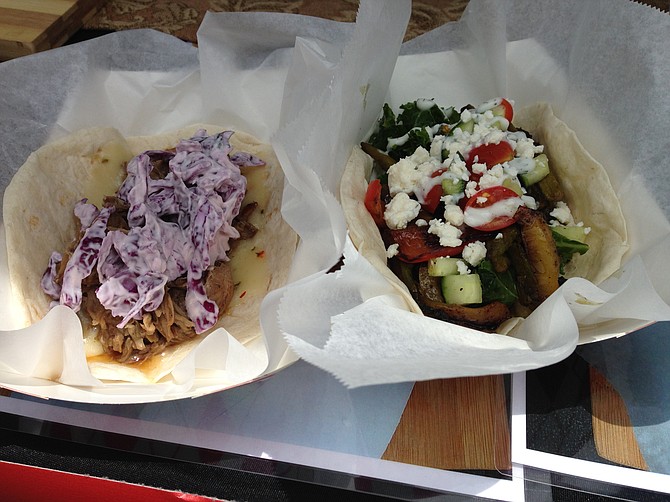 Facebook
Facebook
 X
X
 Instagram
Instagram
 TikTok
TikTok
 Youtube
Youtube

I spend more time than most worrying about the authenticity of tacos. There are thousands of versions in San Diego County, and most would pass any test you might come up with, even those using flour tortillas instead of corn. But more and more I’m seeing tacos that don’t resemble the genuine article, whether due to fusion or gourmet styling. They don’t even evoke the hard-shell gringo-taco variety many of us remember being served in elementary school.

Take Sinner or Saint, the farmers’ market stand I found in Golden Hill last week. It’s owned and operated by a two local women who are testing the waters of their recipes and business model with a relatively small investment in a weekly stall.
Seven tacos were available, and maybe four of them resembled the original Mexican concept. The ones I tried did not.
First there was the Sinner Pulled Pork Taco, which features beer- and coffee-braised pork and horseradish coleslaw folded into a flour tortilla with a melted slice of pepper jack cheese. Then there was the Saint Greek Veggie Taco (all of their tacos are named Saint or Sinner due to some rationale I failed to grasp). This taco really just consisted of a heap of marinated vegetables served in a tortilla. There was a good assortment of veggies: asparagus, kale, cucumber, tomatoes, bell peppers, mushrooms, with a little tzatziki and feta to justify the Greek descriptor. I enjoyed the slightly charred assortment of fresh flavors, and the flour tortilla was heated on the griddle so it was warm and soft, with small pockets of air fluffing it up.
But could I call either of these a taco? It seems to stretch the definition. At some point wrapping something in a flour tortilla became far enough removed from being a burrito that we started calling it a wrap. And there seems to be a consensus preventing flat bread from attaining pizza status (I don’t know why). Even Taco Bell, with its escalating range of food technologies, is veering further away from genuine Mexican influence. “Sriracha quesarito”? “Sausage-biscuit taco”?
The Sinner pulled pork taco was tasty. The melted cheese and horseradish-cabbage gave a spicy bit of contrast to the sweet and tender pork. It does kind of look like a carnitas taco, and I ate it like one. But these flavors don’t scream “south of the border” — they don’t even whisper it.
If calling the Saint Greek a taco can get more people to appreciate the sort of fresh veggies available at the farmers’ market on a weekly basis, I’m all for it. I just have to reconcile it by embracing the literal meaning of the word Spanish settlers used to describe the fish-in-tortilla dishes enjoyed by indigenous peoples of Mexico. Taco means wad. If any wad of food in a tortilla qualifies, then enjoy these tacos.


I spend more time than most worrying about the authenticity of tacos. There are thousands of versions in San Diego County, and most would pass any test you might come up with, even those using flour tortillas instead of corn. But more and more I’m seeing tacos that don’t resemble the genuine article, whether due to fusion or gourmet styling. They don’t even evoke the hard-shell gringo-taco variety many of us remember being served in elementary school.

Take Sinner or Saint, the farmers’ market stand I found in Golden Hill last week. It’s owned and operated by a two local women who are testing the waters of their recipes and business model with a relatively small investment in a weekly stall.
Seven tacos were available, and maybe four of them resembled the original Mexican concept. The ones I tried did not.
First there was the Sinner Pulled Pork Taco, which features beer- and coffee-braised pork and horseradish coleslaw folded into a flour tortilla with a melted slice of pepper jack cheese. Then there was the Saint Greek Veggie Taco (all of their tacos are named Saint or Sinner due to some rationale I failed to grasp). This taco really just consisted of a heap of marinated vegetables served in a tortilla. There was a good assortment of veggies: asparagus, kale, cucumber, tomatoes, bell peppers, mushrooms, with a little tzatziki and feta to justify the Greek descriptor. I enjoyed the slightly charred assortment of fresh flavors, and the flour tortilla was heated on the griddle so it was warm and soft, with small pockets of air fluffing it up.
But could I call either of these a taco? It seems to stretch the definition. At some point wrapping something in a flour tortilla became far enough removed from being a burrito that we started calling it a wrap. And there seems to be a consensus preventing flat bread from attaining pizza status (I don’t know why). Even Taco Bell, with its escalating range of food technologies, is veering further away from genuine Mexican influence. “Sriracha quesarito”? “Sausage-biscuit taco”?
The Sinner pulled pork taco was tasty. The melted cheese and horseradish-cabbage gave a spicy bit of contrast to the sweet and tender pork. It does kind of look like a carnitas taco, and I ate it like one. But these flavors don’t scream “south of the border” — they don’t even whisper it.
If calling the Saint Greek a taco can get more people to appreciate the sort of fresh veggies available at the farmers’ market on a weekly basis, I’m all for it. I just have to reconcile it by embracing the literal meaning of the word Spanish settlers used to describe the fish-in-tortilla dishes enjoyed by indigenous peoples of Mexico. Taco means wad. If any wad of food in a tortilla qualifies, then enjoy these tacos.
Comments